Waterfront usage trends across German metropolitan areas: A social-ecological perspective to urban blue-green infrastructure connectivity
IF 9.2
1区 环境科学与生态学
Q1 ECOLOGY
引用次数: 0
Abstract
The waterfront connects aquatic and terrestrial habitats, and its landscape quality is an indicator of the status of blue-green infrastructure. Especially in urban areas, the consequences of direct human interventions on the waterfront are evident, yet there is a need for more comprehensive and easy approaches to quantify the dynamics of the waterfront landscapes. Herein, we propose a simple, rapid, and effective method, the “Waterfront Development Index” (WDI), for characterizing the relative waterfront usage in metropolitan areas. Based on the Urban Atlas data provided by the Copernicus program of the European Union for German functional urban areas (FUAs), we validate the WDI by comparing waterfront land use and land cover change at federal state, metropolitan, and urban levels (91 FUAs). Our results show remarkable disparities between waterfront land use along running and standing waters. The urban waterfronts covered a wide range of WDI values, highlighting critical urban freshwater waterfronts being relatively more extensively allocated for human land use. Transportation was identified as the most pressing human land use on the waterfronts, especially along the riverbanks. Between 2012 and 2018, 236.5 km of natural, water, or agricultural waterfront have been altered to urban, industrial, and transportation land use. Even though the national level transformation is relatively low (0.4 %), the change ratios of some FUAs are alarming (∼2%). We demonstrate the usefulness and reproducibility of the WDI to monitor and quantify changes in waterfront development over time, posing high relevancy to waterfront landscape conservation, social-ecological systems’ balance, and sustainable urban planning alike.
德国大都市滨水区使用趋势:城市蓝绿基础设施连通性的社会生态视角
滨水区连接着水生和陆地栖息地,其景观质量是蓝绿色基础设施状况的一个指标。特别是在城市地区,直接人为干预对滨水区的影响是显而易见的,但需要更全面、更简单的方法来量化滨水区景观的动态。在此,我们提出了一种简单、快速、有效的方法——“滨水区发展指数”(WDI)来描述大都市地区的相对滨水区利用。基于欧盟哥白尼计划提供的德国功能城区(FUAs)城市地图集数据,我们通过比较联邦州、大都市和城市(91个FUAs)的滨水区土地利用和土地覆盖变化来验证WDI。研究结果显示,沿流水和静水的滨水土地利用存在显著差异。城市滨水区涵盖了广泛的WDI值,突出了相对更广泛地分配给人类土地利用的重要城市淡水滨水区。交通运输被认为是滨水地区,尤其是河岸地区最紧迫的人类土地利用。2012年至2018年间,236.5公里的自然、水或农业滨水区被改变为城市、工业和交通用地。虽然国家层面的变化率相对较低(0.4%),但部分fua的变化率却令人担忧(~ 2%)。我们展示了WDI在监测和量化滨水区发展变化方面的实用性和可重复性,它与滨水区景观保护、社会生态系统平衡和可持续城市规划等方面有着高度的相关性。
本文章由计算机程序翻译,如有差异,请以英文原文为准。
求助全文
约1分钟内获得全文
求助全文
来源期刊

Landscape and Urban Planning
环境科学-生态学
CiteScore
15.20
自引率
6.60%
发文量
232
审稿时长
6 months
期刊介绍:
Landscape and Urban Planning is an international journal that aims to enhance our understanding of landscapes and promote sustainable solutions for landscape change. The journal focuses on landscapes as complex social-ecological systems that encompass various spatial and temporal dimensions. These landscapes possess aesthetic, natural, and cultural qualities that are valued by individuals in different ways, leading to actions that alter the landscape. With increasing urbanization and the need for ecological and cultural sensitivity at various scales, a multidisciplinary approach is necessary to comprehend and align social and ecological values for landscape sustainability. The journal believes that combining landscape science with planning and design can yield positive outcomes for both people and nature.
 求助内容:
求助内容: 应助结果提醒方式:
应助结果提醒方式:


